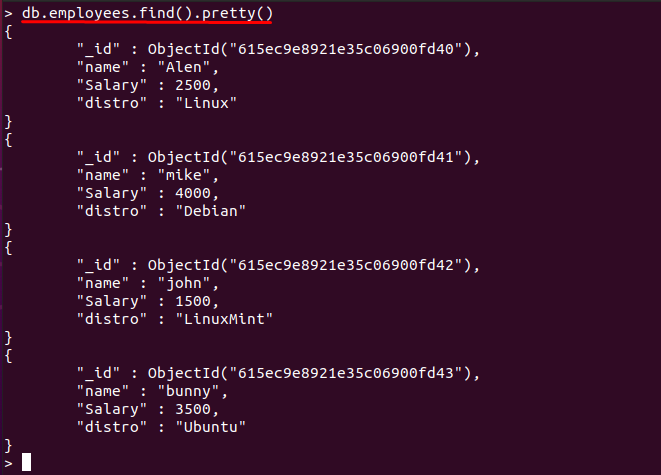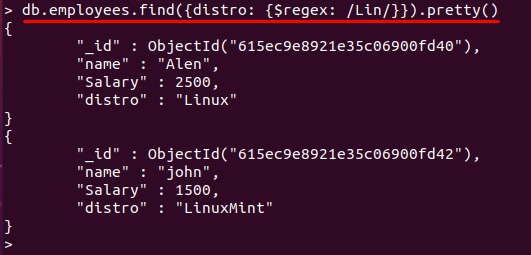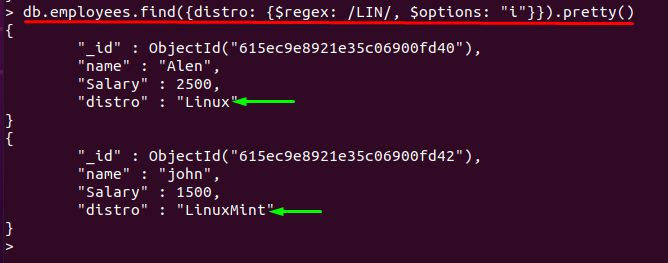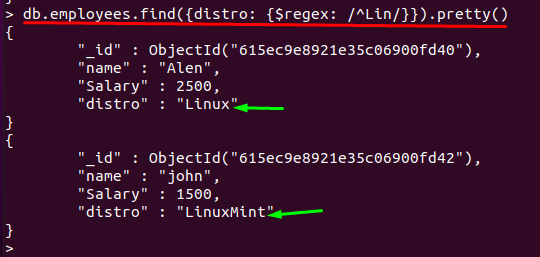Knowing the importance of the $regex operator, this guide is compiled to briefly explain the usage of the $regex operator in MongoDB.
How $regex operator works
The syntax of $regex operator is given below:
Or:
Both the syntaxes work for the $regex operator; however, it is recommended to use the first syntax to get full access to options of $regex. As it is noticed that few options do not work with the second syntax.
pattern: This entity refers to the part of the value that you want to search for a field
options: The options in the $regex operator extend the usage of this operator and a more refined output can be obtained in this case.
Prerequisites
Before practicing the examples, it is required to have the following MongoDB related instances to be present in your system:
MongoDB database: In this guide, a “linuxhint” named database will be used
Collection of that database: The collection associated with the “linuxhint” database is named “employees” in this tutorial
How to use the $regex operator in MongoDB
In our case, the following content resides in the “employees” collection of “linuxhint” database:
This section contains examples that explain the usage of $regex from basic to advanced level in MongoDB.
Example 1: Use of $regex operator to match a pattern
The command given below will check for the “Lin” pattern in the “distro” field. Any field value that contains the “Lin” keyword in its value gets the match. Finally, the documents containing that field will be displayed:
Using $regex with “i” option
Generally, the $regex operator is case sensitive; the “i” option support of $regex operator makes it case insensitive. If we apply “i” option in the above command; the output will be same:
Example 2: Use $regex with caret (^) and dollar ($) sign
As the basic use of $regex matches all the fields that have the pattern in it. You can also use $regex to match the start of any string by prefixing the “caret(^)” symbol and if the “$” symbol is postfixed with characters then the $regex will search for the string that ends with those characters: The query below shows the usage of “^” with $regex:
Any value of the “distro” field that starts with characters “Li” will be retrieved and the relevant document is displayed:
The “$” sign is used after characters to match the string that ends with that character; For instance, the below-mentioned command will get the field value of “distro” that ends with “ian” and the respective documents are printed:
Moreover, if we use “^” and “$” in a single pattern; then $regex will match the string that comprises of exact characters: For instance, the following regex pattern will get only “Linux” value:
Note: The “i” option can be used in any $regex query: in this guide “pretty()” function is used to get the clean output of Mongo queries.
Conclusion
MongoDB is a widely-used open source and belongs to the NoSQL category of databases. Due to its document-based nature, it provides a strong retrieval mechanism supported by several operators and commands. The $regex operator in MongoDB helps to match the string by only specifying a few characters. In this guide, the usage of the $regex operator in MongoDB is described in detail. It can also be used to get the string that starts or ends with a specific pattern. Mongo users can use $regex operator to find a document by using a few characters that match any of its fields.






